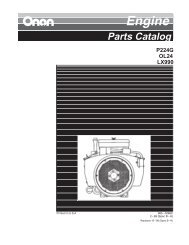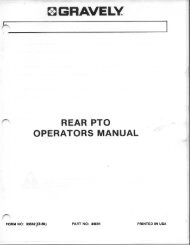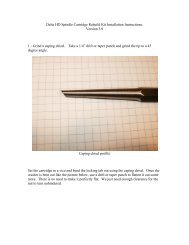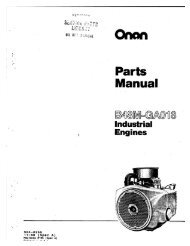272144 Vanguard Twin Cylinder OHV BRIGGS & STRATTON.pdf
272144 Vanguard Twin Cylinder OHV BRIGGS & STRATTON.pdf
272144 Vanguard Twin Cylinder OHV BRIGGS & STRATTON.pdf
Create successful ePaper yourself
Turn your PDF publications into a flip-book with our unique Google optimized e-Paper software.
The battery is not used for the lights, so lights are<br />
available even if the battery is disconnected or<br />
removed. Current for the lights is available when the<br />
engine is running. The output varies with engine<br />
RPM, so the brightness of the lights changes with<br />
engine speed.<br />
Stator assembly (1), Fig. 19.<br />
BLACK lead from stator (2).<br />
ÌÌ<br />
Connector (3).<br />
Two diodes encased in wiring harness (4).<br />
<br />
WHITE lead – 5 amps DC (–) to lights (5).<br />
RED lead – 5 amps DC (+) to battery, clutch (6).<br />
<br />
<br />
Diode Test<br />
<br />
Fig. 20<br />
<br />
<br />
<br />
Fig. 19<br />
<br />
NOTE: One diode is for the charging circuit, the<br />
other diode is for the lighting circuit.<br />
In the DIODE TEST position, the meter will display<br />
the forward voltage drop across the diode(s). If the<br />
voltage drop is less than 0.7 volts, the meter will<br />
BEEP once as well as display the voltage drop. A<br />
CONTINUOUS TONE indicates CONTINUITY<br />
(shorted diode). An INCOMPLETE CIRCUIT (open<br />
diode) will be displayed as OL.<br />
Charging Circuit Test (RED Wire)<br />
Output Test<br />
1. Insert RED test lead into V receptacle in meter.<br />
2. Insert BLACK test lead into COM receptacle.<br />
3. Rotate selector to V~ (AC VOLTS) position.<br />
4. Attach RED test lead clip (1) to output terminal<br />
(GREEN connector), 20.<br />
5. Attach BLACK test lead clip (2) to engine<br />
ground.<br />
6. With engine running at 3600 RPM, output should<br />
be no less than 28 VOLTS AC.<br />
7. If NO output or LOW output is found, replace<br />
stator.<br />
8. If alternator output is good, test the diodes in the<br />
wiring harness.<br />
1. Insert RED test lead into V receptacle in meter.<br />
2. Insert BLACK test lead into COM receptacle in<br />
meter.<br />
3. Rotate selector to +))))) (DIODE TEST) position.<br />
4. Attach BLACK test lead clip (2) to point A of the<br />
RED wire (3), Fig. 21. (It may be necessary to<br />
pierce wire with a pin as shown.)<br />
5. Insert RED test lead (1) into harness connector.<br />
a. If meter BEEPS once, diode is OK.<br />
b. If meter makes a CONTINUOUS TONE,<br />
diode is shorted. Replace harness.<br />
c. If meter displays OL proceed to step 6.<br />
6. Reverse test leads.<br />
a. If meter BEEPS ONCE, diode is installed<br />
backwards. Replace harness.<br />
b. If meter still displays OL, diode is open.<br />
Replace harness.<br />
39

















